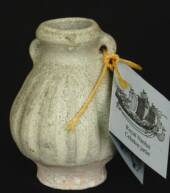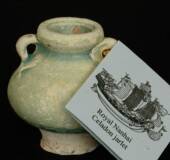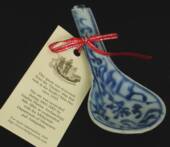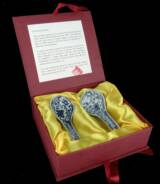Sten has spent more than forty years in Southeast Asia designing and engineering various marine structures. His interest in Asia's pottery and porcelain eventually lead to his search and excavation of numbers of ancient shipwrecks. As a championship sailor Sten has extensive knowledge and interest in ancient maritime trade, ships designs and construction. It is these interests and gained knowledge that is the base for all his books and extensive lecturing.
Sten's company; Nanhai Marine Archaeology Sdn. Bhd. works with Malaysia's Department of Museums and Antiquities and can therefore offer legally excavated artifacts from these shipwrecks.
In addition to working with recovering artifacts, Sten has located number of ancient kiln sites in Thailand and in China were his shipwreck ceramics was made centuries ago. He is therefore able to offer absolute provenance on all ceramics sold via Nanhai Marine Archaeology Sdn. Bhd. and, with good conscience sign every Certificate of Authenticity supplied with the artifacts.
The maritime archaeology of Sten Sjostrand has led to major advances in the study of Asian trade and trade ceramics in Southeast Asia. His meticulous documentation of a series of nine shipwrecks from the 11th to 19th centuries reveals the early dominance of Chinese trade ceramics, a subsequent loss of the Chinese monopoly in the late 14th century when Southeast Asian ceramics entered the market, the basic parameters of the Ming gap shortages of the 14th-15th centuries, and a resurgence of Chinese wares in the 16th and 17th centuries. Just as important, Sjostrand freely shares the information from his discoveries. Researchers are welcome at his headquarters where he documents his finds and patiently answers the queries of others. A lifetime’s experience with the sea and sailing allows Sjostrand to bring new understanding to ancient ship construction, and his voluminous reading allows him to set the ships and their cargoes in historical perspective.
Dr. Roxanna M. Brown
Director.
Southeast Asian Ceramics Museum
Bangkok University, Rangsit campus
Pathum Thani 12120, Thailand
Royal Nanhai Jarlets (c. 1460)
These small celadon bottles have lost most of their glaze due to ocean-wear. Their low-fired celadon glaze consists of 1.2 - 1.5 % iron oxides that turn green during reduction-atmosphere firing. If sufficient temperature was not achieved, the iron oxide would accumulate on the surface in the form of iron crystals. From prolonged contact with salt water, the crystals will corrode and slowly age the surface.
The jarlets were made in two main forms. One is slightly taller and often feature vertical striations. The other is more roundish and usually undecorated.
These jarlets were previously thought to hold "precious oil". With the discovery of one shipwreck, the Royal Nanhai, containing thousands of pieces, we now question how much "precious" oil there may have been in the 15th century! This contribution to earlier research is yet another benefit with ship-wrecks: All items onboard must be from one time-period and represent trade wares available at that time in history.
These delicate blue & white spoons are each different in design and shape created by the gentle sweep of the old potters thumb.
Historical shipwreck sites most often reveal some mystery with early trade and these spoons are no exception. Perhaps it was Mr. Sin Guan Hup, whose seal stamp was found onboard, that carried thousands of these spoons to set up a new shop at the ships destination
Gift box with silk lining, two spoons and information tag stamped with Sin Guan Hup's original seal.
Size: 16x14x5 cm
Shipping weight: 0.7 kilo
Tall Celadon Jarlet from the Royal Nanhai (c.1460) shipwreck.
5 - 6 cm in height.
Individually hand-crafted 540 years ago, these jarlets vary in size and form and carry unique detailing. Since manufacturing they have been worn by the ocean and developed individual characteristics, reflecting their extraordinary history.
Old time pottery and collectibles from the Desaru (c.1830) shipwreck
For more collectibles, click on:
Old time pottery and other collectibles sold here are genuine antiques from our own marine archeological excavations. The collectibles and old time pottery for sale on these pages are the best buy the Internet can offer. Although genuine historical objects, they are affordable. Since when could you find an 550 year antique collectible for 9 dollars?
The below celadon jarlets are genuine antiques and the best buy collectibles available on the net.
Collectibles, antiques, free collectibles
Old time pottery, giftware and antique pottery from marine archeology in South China Sea...Best priced collectibles for sale
REST ASSURED OF PROPER AUTHENTICITY
When ordering from these pages you are dealing directly with a team of dedicated researchers that excavated, recovered and researched every single artifact offered for sale. We encourage you to contact our Sten Sjostrand with any questions which you may have
OUR GUARANTEE:
If you are not satisfied with our artifacts, delivery service or; if you obtain an expert opinion
that a delivered item is not of the age stated by us, just return it and we will issue full refund
See how the spoons were found and recovered from the Desaru (c. 1830) shipwreck
Spoon with attached information tag.
Lenght: 11 cm.
THE ONLY PLACE WHERE YOU CAN BE SURE TO BUY GENUINE ANTIQUES
Nanhai Marine Archaeology Sdn. Bhd. was incorporated on the recommendation of the Malaysian authorities. This was done in order to formalize and to expand on the company’s researcher’s extensive knowledge of Asia’s ceramic developments and maritime trade.
The company’s researchers have been engaged in the search for historical shipwrecks for more than two decades and another decade researching maritime trade. Most of this work is concentrated to the South China Sea, a virtual highway for ancient shipping linking China to India, the Middle East and Southeast Asia in an extensive maritime trade system. This ancient trade started sometime around the 4th century and lasted well into the 19th century.
Following a successful shipwreck discovery, the company obtain a government permit to excavate the wreckage, and then carry out detailed marine archaeological procedures in recovering the artifacts, mapping the ship's remains and securing other data for future research. After each concluded project and following conservation of recovered artifacts, we search for and pinpoint ruined kiln sites and compare its wasters with the recovered ceramics until we are satisfied we located the place in which the shipwreck pottery was made centuries earlier.
As such we have precisely located a kiln sites in Sisatchanalai, northern Thailand in which our Royal Nanhai and the Nanyang shipwreck celadon ware was made around AD. 1380-1460. (See videos on: http://www.ming-wrecks.com/photopage.html ) Other kilns was located in Sukhothai where production wasters matched the fish and flower plates found on the Turiang and the Longquan shipwreck. These unique underglaze decorated wares was made at those exact kilns 600 years earlier! Our latest shipwreck cargo; The Wanli Shipwreck, of Chinese blue and white porcelain, was likewise pinpointed to the Guangyinge kiln site in Jingdezhen, China. (See video on: http://www.ming-wrecks.com/photopage.html )
Our arrangement with the Malaysian authorities is such that we finance all operations and train young Malaysian nationals (on our initiative) in maritime archaeology and related research. After giving all unique and single artifacts and thirty percent of all recovered items to the National Museum (and assisting with exhibitions of artifacts from each project) we are allowed to sell our portion of the recovery to finance future projects. The findings from ongoing research and the compilation of reports, books and catalogues are available on these pages as well as on a separate Internet site: http://www.maritimeasia.ws
Due to the unquestionable authenticity and precisely dated shipwreck pottery, many International Museums now display our shipwreck pieces as reference material.
The artifacts sold on this website are therefore legally and properly excavated and can be supplied with an export permit from the Department of Museum in Malaysia should this be required. This unique working arrangement makes us one of the few Internet sellers that sell from own excavation and issues a meaningful Certificate of Authenticity for every artefact with a serial number.
So, if you are interested to purchase some of our Antique porcelain, old time pottery or other shipwreck artifacts from the Song dynasty, Ming porcelain or Chinese blue and white porcelain or the famous Yixing teapots, you can rest assured that every piece is excavated through proper archaeology by our own staff. We do not sell anything that is not excavated by ourselves or properly recorded and researched before offered for sale so every piece comes with the “Best possible provenance”
WE ENCOURAGE YOU TO EMAIL OUR PRINCIPAL RESEARCHER; Sten Sjostrand SHOULD YOU HAVE ANY QUESTIONS ABOUT YOUR POSSIBLE PURCHASE
The search and discovery of the Royal Nanhai
(c. 1460) shipwreck. The video include footage from the very first dive on the site by a Remote Operated Vehicle.
Bowls and from the 540 years old Royal Nanhai (AD. 1460) shipwreck
This type of celadon bowls has deteriorated to various degree during their centuries long stay on the seabed. This deterioration is due to undisolved (low-fired) iron oxides in the glaze matrix. Each artifact is hand made and therefore individual in size, shape and quality. Ordered artifacts may therefore be slightly different from the one shown. We do however assure you that the general appearance (and authenticity) is comparable whilst we will attempt to send items of no lesser quality than that seen on the pictures to the left.
We are PayPal Verified
for safe Online payments
 | ||||
Nanhai Marine Archeology LLC. Delaware. USA.
25 Jalan Wawasan Jaya. Kuala Rompin. Pahang. Malaysia
Phone: + 60 12 761 4759 Fax: + 60 3 211 01673
Copyright (c) 2012 Nanhai Marine Archaeology Sdn Bhd
CLICK ON BELOW IMAGES TO VIEW OUR SALES PAGES
 | ||||
Nanhai Marine Archeology LLC.
as agents for Nanhai Marine Archaeology Sdn. Bhd. Malaysia.















